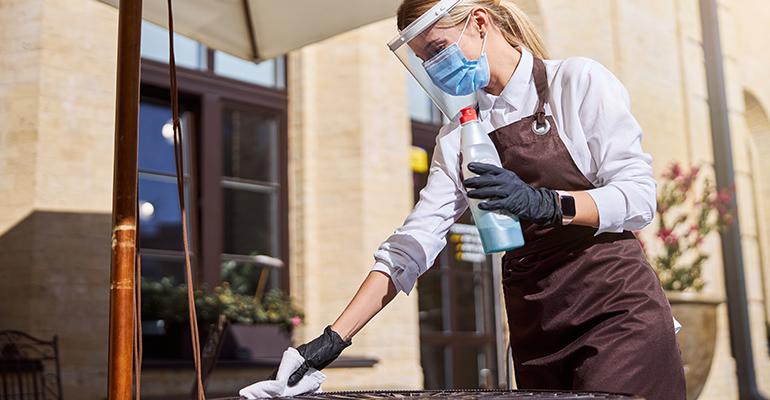To describe 2020 as a challenging year for the restaurant industry would be an understatement. With indoor dining shut down or severely restricted across the country, many unforeseen expenses were incurred to quickly create or expand outdoor seating, takeout and drive-thru options. Then, as restrictions began to lift, restaurants of all sizes faced many more expenditures to provide safe and comfortable conditions to the returning customers.
Those expenses included improvements to old — or installations of new — air-filtration or ventilation systems (e.g., HVACs); purchasing of specialized equipment; installation of physical barriers; supplying of personal protective equipment (PPE) and more.
One small silver lining is that these expenses also created significant tax deferral opportunities that can help mitigate the resulting financial burdens on restaurants. Here’s what you need to know about which purchases can produce great tax benefits:
Bonus depreciation
In general, when a restaurant purchases equipment, furniture, or appliances, or makes improvements to leased or owned real property, it is allowed to deduct the cost of those assets over their Internal Revenue Service-assigned useful lives. This cost recovery is achieved through annual depreciation expense that is claimed on the company’s annual income tax return.
The Internal Revenue Code provides businesses with an opportunity to accelerate these deductions by taking advantage of additional first-year depreciation (“bonus” depreciation) on qualified depreciable property. Bonus depreciation is available in some — but not all — states. It can create significant tax planning opportunities for restaurants.
 Photo: Anton Rayetskyy
Photo: Anton Rayetskyy
Prior to the Tax Cuts and Jobs Act (TCJA), which was passed in 2017 and made several favorable amendments to tax-depreciation rules, a restaurant was generally able to claim a 50% bonus depreciation deduction in connection with the purchase of qualifying new property. Examples of such assets included machinery, equipment, furniture, and qualified improvement property (QIP, further defined below).
Taking 50% bonus meant that a business could immediately expense 50% of the cost of these assets in the first year they were placed in service. TCJA significantly expanded bonus depreciation rules and increased the deduction of qualified property to 100%.
The tax law provides other opportunities to accelerate deductions related to certain acquisitions and repairs, but this article is focused on opportunities coming from bonus depreciation.
What is eligible for bonus depreciation?
Many restaurant expenditures including leasehold improvements and upgrades will be eligible for bonus depreciation. Qualified property includes depreciable assets with useful lives of 20 years or less and would typically include the above-mentioned assets.
 Photo: Richard Shevak
Photo: Richard Shevak
One category of property that is eligible for bonus depreciation is “Qualified Improvement Property” (QIP). QIP is any improvement to the interior portion of a commercial building done after the building was initially placed in service. It does not include work done to an elevator or escalator, building expansion, or work done to the “structural framework” of the building.
Congress intended that QIP would fit into the category of assets eligible for bonus depreciation. However, a drafting error in the TCJA caused it to be treated as 39-year property and therefore made it ineligible for bonus depreciation.
Fortunately, the Coronavirus Aid, Relief, and Economic Security (CARES) Act, which was passed in March of last year in response to COVID-19 pandemic, finally corrected the drafting error to make QIP a 15-year property and eligible for 100% bonus depreciation. In other words, it restored the original intent of the TCJA to allow full deduction of essentially all depreciable business assets that are typically purchased by restaurants.
So, what does this mean for restaurants?
Bonus depreciation means potential additional tax deductions and immediate expensing of the costs that restaurants were forced to incur to navigate through COVID-19-related disruptions. Though the money was spent, there are opportunities to lessen that financial burden by accelerating tax deductions. Below we cover some common costs that were and continue to be incurred by restaurants and discuss their deductibility.
- Leasehold improvements and interior building upgrades (including HVAC): As noted above, QIP is any improvement to the interior portion of a commercial building placed in service after the building itself. Interior improvements could include, for example, the cost to upgrade interior HVAC components to better filter the air in the restaurant. Exterior components such as rooftop units would not be QIP. QIP can include a wide range of other interior improvements, such as interior lighting and electrical upgrades, construction of interior walls, flooring, ceiling tiles and bathroom upgrades.
- Construction of outdoor seating areas: These costs can include the construction of plastic, material or wooden enclosures; purchasing of outdoor lighting equipment; and installation of mounted or free-standing heater lamps.
In general, movable property such as furniture and equipment have shorter useful lives, which makes them eligible for bonus depreciation deduction. Since in most cases these outdoor tents or enclosures are built on sidewalks and/or roadways and not permanently fixed to a building or land, they are movable and will potentially be considered a qualifying asset. Therefore, the costs of building outdoor enclosures, including installation of lighting and heating equipment, could be eligible for 100% bonus depreciation.
Careful analysis should be performed if the outdoor space, including any electric components, is constructed as a continuation of and permanent attachment to a restaurant. This will likely be considered a 39-year property and ineligible for bonus treatment.
- Physical barriers for indoor and outdoor seating: Similar to movable constructed outdoor enclosures, physical barriers placed to create separations between tables and customers could be assigned a useful life of less than 20 years and therefore be eligible for 100% bonus depreciation.
- Protective personal equipment (PPE): Examples of these costs include masks, face shields, gloves, social distancing signs, hand sanitizers with or without stands, and portable thermometers. In most cases, these expenses will not be considered assets with useful lives going beyond one year and therefore will not have to be capitalized and depreciated. Instead, they could be considered as materials and supplies deductible when incurred.
Note, however, that regardless of 100% bonus eligibility, depreciable assets that don’t qualify for the additional deduction will still generate annual depreciation expense spread over their assigned useful lives.
It is also important to note that not all states follow the federal rules. Check with your tax service provider for more information on state rules relevant to you.
As you can see, these rules can get complicated and can vary for each restaurant. However, the potential tax benefits can be significant, so consult with your tax advisor to determine the correct and most beneficial treatment in your situation.
Anton Rayetsskyy is a senior tax manager in CohnReznick’s New York office and a member of the firm’s Hospitality Industry Practice. Richard Shevak is a principal in CohnReznick’s National Tax Practice and heads the firm’s tax fixed asset and accounting methods practice.
This article does not necessarily reflect the opinions of the editors or management of Nation’s Restaurant News and Restaurant Hospitality.





